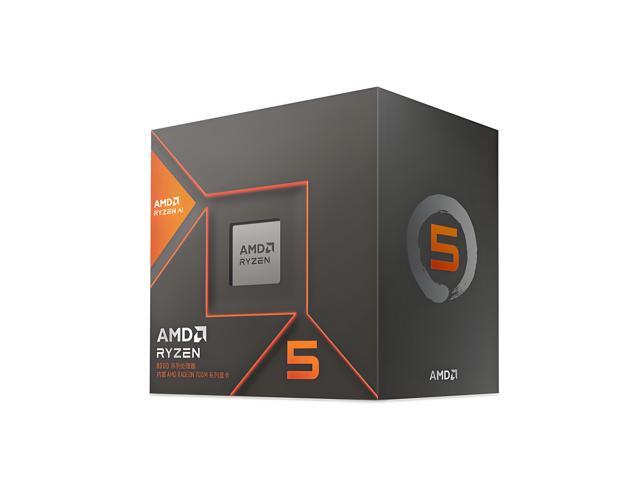Conclusion
When AMD announced the Ryzen 8000G series APUs back at CES in early January 2024, we were quite excited about what it could bring to the table in integrated graphics performance on the desktop. We wanted to get our hands on these new APUs, and thoroughly run a focused gaming performance review on the integrated graphics performance of the Radeon 700M series RDNA 3 powered graphics.
We had previously reviewed the Ryzen 7 5700G in several different ways, including integrated graphics performance compared to the then-current Intel CPU at the time. The Ryzen 7 5700G and 5600G, came out quite a while ago in April of 2021, and were based on Zen 3 CPU architecture and AMD Radeon Vega graphics, notably the Vega 8 in the 5700G. Compared to these APUs, the new Ryzen 8000G series APUs are a huge leap in graphics architecture, now running RDNA 3 graphics architecture, it’s a big step up in features and performance. The 5700G and 5600G didn’t even support things like ray tracing or mesh shaders, something the new Ryzen 8000G APUs now do, so support in the latest games is there.
In our gaming-focused review today, we put the Ryzen 7 8700G and Ryzen 5 8600G through its paces in 17 games at 1080p testing up and down game graphics settings from Low to Ultra, and also including FSR upscaling performance where supported. We think testing FSR is important on lower-performing graphics such as these, this is where you’ll want to improve performance and latency the most, and some image quality loss may be acceptable to gain the performance needed to actually play the game.
Performance
You can read all of the percentage differences in the text under each game, for our detailed analysis. We talked about how much faster the 8700G and 8600G was compared to the 5700G, and then also talked about the difference in performance between the 8700G and 8600G, as well as how much performance FSR adds to each game. Therefore, we won’t go over every single game’s performance here, read each game page for that, for this summary, we will just briefly talk about the advantages the 8700G and 8600G have over the 5700G.
Overall, we saw huge gains in performance of the 8700G and 8600G over the 5700G. The 8700G was a lot of times, more often than not, more than double the performance of the 5700G. We experienced many results that were 110%, or 120% or 130% faster than the 5700G, with the new 8700G. In fact, some were even higher in the 140-150% range. The Ryzen 5 8600G was also no slouch in comparison to the 5700G, it was usually in the 70-80% faster range, but there were some games where it too was double the 5700G or 100% faster. Therefore, in about 3 years, we are getting a massive 100%+ performance gain in integrated graphics from AMD’s APU side of things. You don’t usually get that much of a performance uplift with discrete GPUs in that timeframe, so this is commendable.
When we looked at how much performance difference there is between the 8700G and 8600G, we saw mixed results based on the game. There were some games where the difference was only 10% between them, but then there were others that were into around 20% difference. We found that when the APUs were bottlenecked, the percentage differences narrowed, but as they were not, it could widen as much as 20% between them in gaming performance.
When looking at what that translates to in terms of playable game settings, well that depends a lot on the game. If it’s an older game, several years back, that could mean High or Ultra settings may be playable on the 8600G or 8600G. However, if you are looking at brand-new games, or demanding games that are recent, it may only mean Low settings are playable. There were many games where Medium felt fine, or even High, but a lot of the newer games were pretty much still only playable at the Low-quality settings.
FSR Upscaling
One feature that can help performance is FSR upscaling. We can debate all day long about actually using FSR upscaling at a resolution like 1080p, but the fact is that when you have integrated graphics performance at this level, you’ll do whatever you can to get a smoother experience or a higher framerate. You might be willing to turn down graphics settings more or use upscaling (cutting down the render resolution) in order to gain a smoother experience. You don’t really have many choices, but this is one of those choices available to you, so it is important to test.
Keep in mind that FSR upscaling can also improve latency, and latency is so very important at lower framerates and means a whole lot more for APUs of this caliber of performance. You may be ok with taking the visual quality hit, in order to gain better latency and smoothness. In addition, the image quality of FSR upscaling will depend on the game’s implementation. Some games have poor implementations, while others have very good implementations using the later FSR versions like FSR 2.2.
Therefore, it is game-dependent, but FSR upscaling can be a means to providing a playable experience on the Ryzen 7 8700G and Ryzen 5 8600G in newer game titles. If you stick with the Quality FSR setting, at least you know you’re getting the highest quality FSR upscaling you can get, and it’s not always bad. It’s something to be aware of, and it was important that the performance was tested so that you can make that decision for yourself and that you know how it performs.
Final Points
At the end of the day, the AMD Ryzen 8000G series APUs (notably the Ryzen 7 8700G and Ryzen 5 8600G) are phenomenal upgrades over the previous generation. Whatever your take is on the application and use case for APUs, you cannot deny the engineering endeavors that went into the new Ryzen 8000G series APUs, and how much of an upgrade these really are from the previous generation.
The Ryzen 7 8700G and Ryzen 5 8600G are based on the latest AM5 platform, using the latest Zen 4 CPU architecture and the latest RDNA 3 graphics architecture and utilizing DDR5 on the desktop. These new APUs are pulling from AMD’s latest technologies, and finally, we have an APU from AMD that uses the latest graphics architecture unlike the 5000G series APUs did with Radeon Vega graphics. It is nice to have this synergy of technologies from AMD utilizing the most current architectures on both ends.
We believe that there is a use case for APUs like the Ryzen 7 8700G and Ryzen 5 8600G, and there is a market for it. If you simply need a small computer, as small as possible, and cannot use or do not need, a discrete GPU, these APUs are perfect for you. It will allow you to do some gaming in a desktop form factor. You know who you are if you need this, and for you, we put this gaming-focused review together so you will know what you can get out of the Ryzen 7 8700G and Ryzen 5 8600G in terms of gaming performance, and what FSR can provide to boost that performance.
Will APUs ever replace the low-end budget discrete GPU gaming space? Maybe not this generation, but with what we are seeing here today, we can definitely see a future where that could happen. The Ryzen 7 8700G and Ryzen 5 8600G really do offer something unique in the desktop space that the competition simply does not have. If you are running the previous generation APUs from AMD, the new 8000G series will offer a substantial upgrade.





